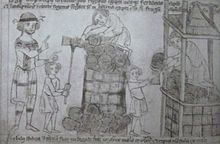Rutenberg (agriculture)

A Rutenberg ( Dutch : Roedenberg or Hooiberg ) is a roofed, but open on all sides harvest pile construction for non-threshed grain , straw or hay , which was particularly widespread in northwest Germany and the Netherlands. The Rutenberg has been archaeologically verifiable in Europe since the Iron Age .
Construction
Rod mountains are usually built within a courtyard . They consist of up to twelve vertically standing wooden posts (bargrutes), which are arranged in a circular, evenly spaced manner. Rutenberg also occurs regionally as rectangular four-post structures. The total height could be about 15 to 17 meters, the diameter up to about 7 meters. A floor slab is drawn in between the posts at a height of about 2 meters. In the space below the floor, agricultural equipment could also be stored or cattle sheltered.
In contrast to a Diemen , a rod mount is equipped with a height-adjustable roof that could be adjusted using wooden stakes or bolts, depending on the amount to be stored.
Either hay, straw or non-threshed grain could be stored in a Rutenberg. The latter was stacked on the stalk with the ear of corn inside. In this way, the harvest could be protected and stored dry. Due to the open construction, the risk of spontaneous combustion of the crop was reduced compared to storage in a barn .
The first traditional description of a Rutenberg comes from the first half of the 13th century from the Sachsenspiegel by Eike von Repgow . The Oldenburg illuminated manuscript of the Sachsenspiegel from 1336 contains a description of a Rutenberg as well as a graphic representation. An illustration of a Rutenberg can also be found in the Bohemian Velislaus Bible from the mid-14th century.
In the archaeological evidence , a Rutenberg is usually indistinguishable from a roofless Diemen. Since the construction plan of both types of harvest storage has remained almost the same since the Iron Age, recent rod mountains or diemen can be used as a reconstruction aid for archaeological findings. However, prehistoric rod mountains differ in size from modern buildings. On average, these are smaller and only have a diameter of between 4 and 6 meters. There are also central posts in the floor plans, which should probably support the floor slab.
distribution
Rutenbergs have been known archaeologically since the Iron Age and occur in rural settlements from Scandinavia to Central and Eastern Europe. In modern times, the main distribution area of the Rutenberg is mainly in the north-west of Germany and the Netherlands. But they also occur in the Alpine region. They were still in frequent use until the beginning of the 20th century, but have almost completely disappeared today. Emigrants also brought this type of construction to North America .
etymology
The term Rutenberg is made up of the expressions "Rute" and "Mountain". Rod refers to the wooden stakes that form the basic structure. Berg is derived from Barg, a Low German word for bergen, store.
A courtyard on which such a Rutenberg stood was called “Barghof”, or, in some variations, “Barkhof”.
literature
- Ludwig Uphoff: “Barg” in the Vierlanden. In: Deutsche Volkskunde 3. 1941, pp. 153–155.
- Wolf Haio Zimmermann : Harvesting in Rutenberg and Diemen from an archaeological and ethnological point of view. Néprajzi Értesítö 71-73, 1991, pp. 71-104. Digital copy, PDF (size 0.7 MB)
- Wolf Haio Zimmermann: The Rutenberg - an agricultural outbuilding for collecting field crops and hay. In: Mamoun Fansa (ed.): The sassen speyghel: Sachsenspiegel - law - everyday life. Volume 2: Taken from life - a legal book reflects its time. Archaeological communications from northwest Germany. Beiheft 10, Oldenburg 1994, pp. 207-216.
Web links
Individual evidence
- ↑ Zimmermann, p. 76.
- ^ Landrecht, Third Book 45 §8.
- ↑ Zimermann, p. 80.
- ^ Michael Richey : Idioticon Hamburgense . 1755, pp. 355f.


